sensor SAAB 9-5 2009 Owner's Manual
[x] Cancel search | Manufacturer: SAAB, Model Year: 2009, Model line: 9-5, Model: SAAB 9-5 2009Pages: 272, PDF Size: 21.53 MB
Page 219 of 272

219 Car care and technical information
Relays
10 15 High beam headlight, left
11 15 Low beam headlight left
12 15 High beam headlight, right
13 15 Low beam headlight, right
14 30 Radiator fan, high speed
15 15 Fog lights (front spoiler)
16 20 Wiper, rear
17 15 Horn
18 – –
# Function
1 Bulb test; head light; high beam flasher
2 Headlight washer
3 Front fog lights
4 Wiper, rear (9-5 SportCombi)
5–
6–
7 Rain sensor
8 Radiator fan, low speed
9 Radiator fan, high speed
10 A/C-compressor
11 Radiator fan, high speed, right fan
12 Horn
13 Extra lights (accessory)
14 High beam headlight
15 Low beam headlight
16 –
17 Windshield wipers
95_US_MY09.book Page 219 Tuesday, April 15, 2008 11:03 AM
ProCarManuals.com
Page 231 of 272
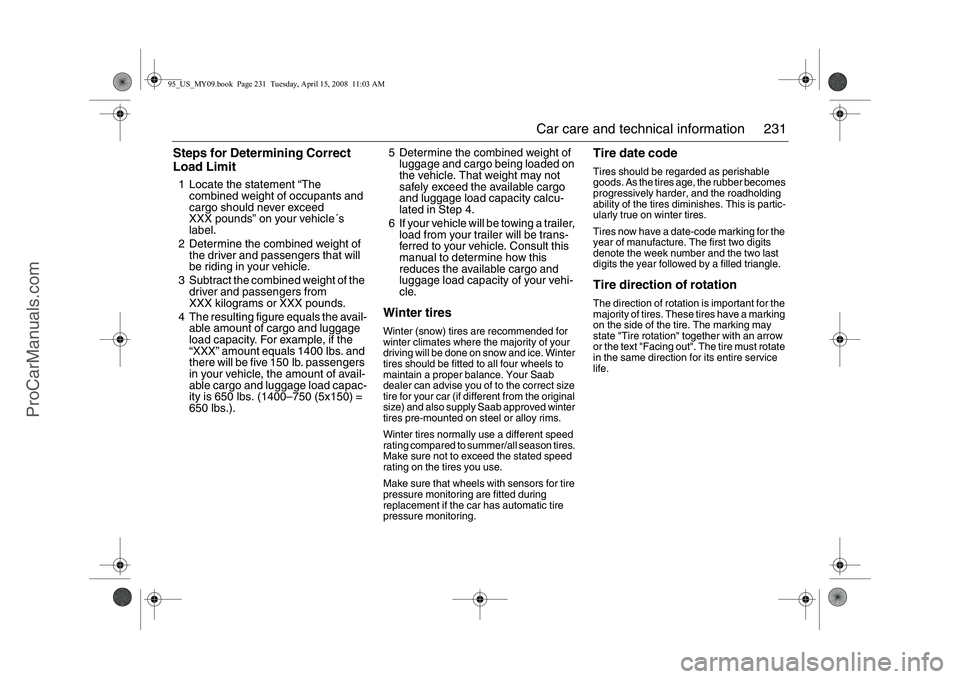
231 Car care and technical information
Steps for Determining Correct
Load Limit1 Locate the statement “The
combined weight of occupants and
cargo should never exceed
XXX pounds” on your vehicle´s
label.
2 Determine the combined weight of
the driver and passengers that will
be riding in your vehicle.
3 Subtract the combined weight of the
driver and passengers from
XXX kilograms or XXX pounds.
4 The resulting figure equals the avail-
able amount of cargo and luggage
load capacity. For example, if the
“XXX” amount equals 1400 lbs. and
there will be five 150 lb. passengers
in your vehicle, the amount of avail-
able cargo and luggage load capac-
ity is 650 lbs. (1400–750 (5x150) =
650 lbs.).5 Determine the combined weight of
luggage and cargo being loaded on
the vehicle. That weight may not
safely exceed the available cargo
and luggage load capacity calcu-
lated in Step 4.
6 If your vehicle will be towing a trailer,
load from your trailer will be trans-
ferred to your vehicle. Consult this
manual to determine how this
reduces the available cargo and
luggage load capacity of your vehi-
cle.
Winter tiresWinter (snow) tires are recommended for
winter climates where the majority of your
driving will be done on snow and ice. Winter
tires should be fitted to all four wheels to
maintain a proper balance. Your Saab
dealer can advise you of to the correct size
tire for your car (if different from the original
size) and also supply Saab approved winter
tires pre-mounted on steel or alloy rims.
Winter tires normally use a different speed
rating compared to summer/all season tires.
Make sure not to exceed the stated speed
rating on the tires you use.
Make sure that wheels with sensors for tire
pressure monitoring are fitted during
replacement if the car has automatic tire
pressure monitoring.
Tire date codeTires should be regarded as perishable
goods. As the tires age, the rubber becomes
progressively harder, and the roadholding
ability of the tires diminishes. This is partic-
ularly true on winter tires.
Tires now have a date-code marking for the
year of manufacture. The first two digits
denote the week number and the two last
digits the year followed by a filled triangle.Tire direction of rotationThe direction of rotation is important for the
majority of tires. These tires have a marking
on the side of the tire. The marking may
state "Tire rotation" together with an arrow
or the text "Facing out". The tire must rotate
in the same direction for its entire service
life.
95_US_MY09.book Page 231 Tuesday, April 15, 2008 11:03 AM
ProCarManuals.com
Page 232 of 272
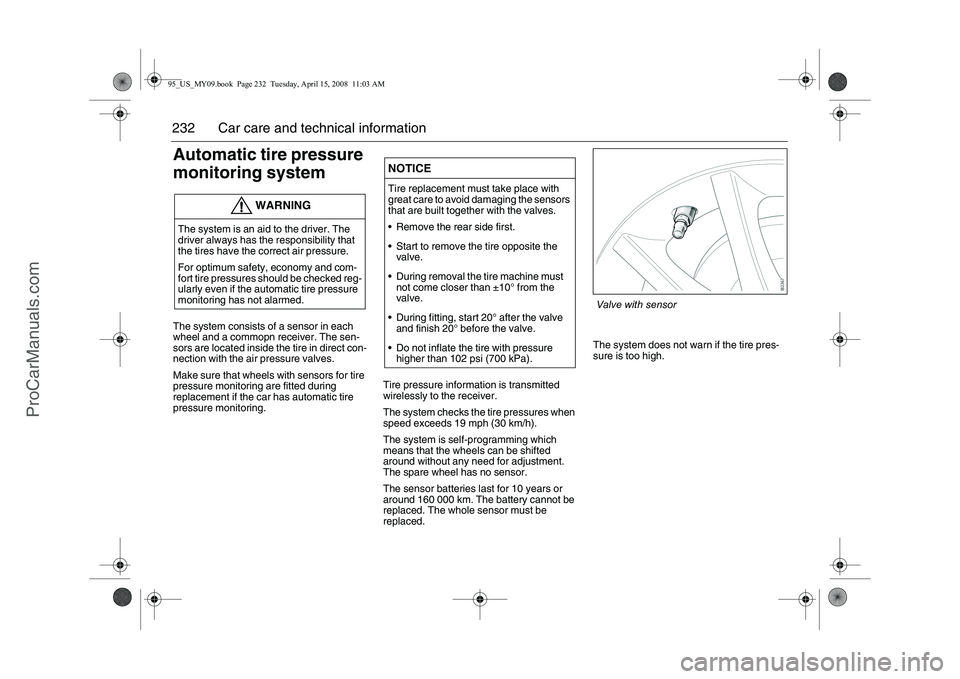
232 Car care and technical informationAutomatic tire pressure
monitoring systemThe system consists of a sensor in each
wheel and a commopn receiver. The sen-
sors are located inside the tire in direct con-
nection with the air pressure valves.
Make sure that wheels with sensors for tire
pressure monitoring are fitted during
replacement if the car has automatic tire
pressure monitoring.Tire pressure information is transmitted
wirelessly to the receiver.
The system checks the tire pressures when
speed exceeds 19 mph (30 km/h).
The system is self-programming which
means that the wheels can be shifted
around without any need for adjustment.
The spare wheel has no sensor.
The sensor batteries last for 10 years or
around 160 000 km. The battery cannot be
replaced. The whole sensor must be
replaced.The system does not warn if the tire pres-
sure is too high.
WARNING
The system is an aid to the driver. The
driver always has the responsibility that
the tires have the correct air pressure.
For optimum safety, economy and com-
fort tire pressures should be checked reg-
ularly even if the automatic tire pressure
monitoring has not alarmed.
NOTICETire replacement must take place with
great care to avoid damaging the sensors
that are built together with the valves.
Remove the rear side first.
Start to remove the tire opposite the
valve.
During removal the tire machine must
not come closer than ±10° from the
valve.
During fitting, start 20° after the valve
and finish 20° before the valve.
Do not inflate the tire with pressure
higher than 102 psi (700 kPa).
Valve with sensor
95_US_MY09.book Page 232 Tuesday, April 15, 2008 11:03 AM
ProCarManuals.com
Page 233 of 272
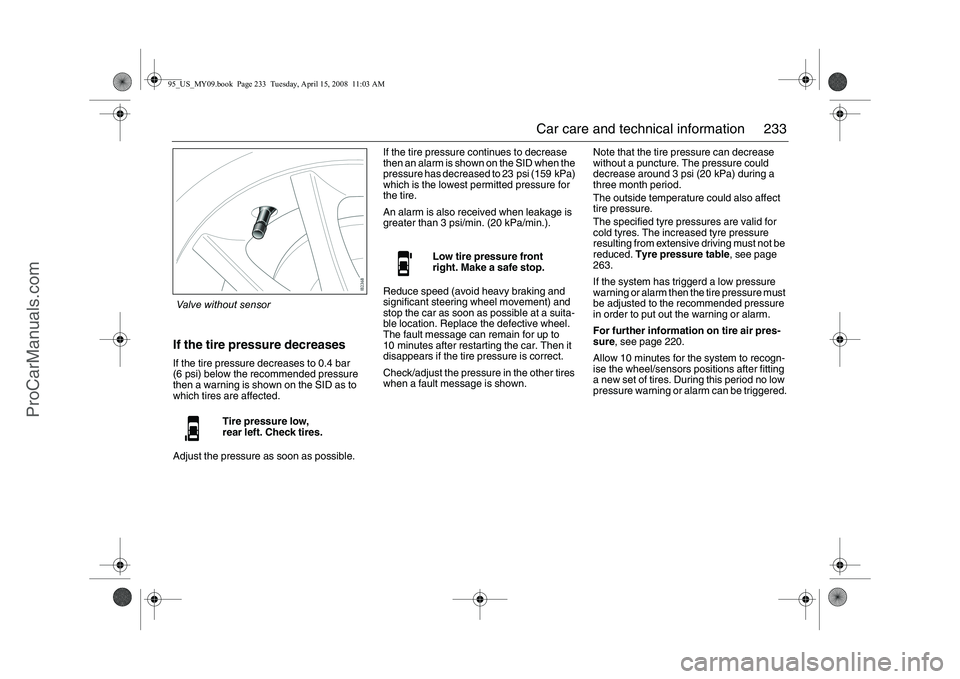
233 Car care and technical information
If the tire pressure decreasesIf the tire pressure decreases to 0.4 bar
(6 psi) below the recommended pressure
then a warning is shown on the SID as to
which tires are affected.
Adjust the pressure as soon as possible.If the tire pressure continues to decrease
then an alarm is shown on the SID when the
pressure has decreased to 23 psi (159 kPa)
which is the lowest permitted pressure for
the tire.
An alarm is also received when leakage is
greater than 3 psi/min. (20 kPa/min.).
Reduce speed (avoid heavy braking and
significant steering wheel movement) and
stop the car as soon as possible at a suita-
ble location. Replace the defective wheel.
The fault message can remain for up to
10 minutes after restarting the car. Then it
disappears if the tire pressure is correct.
Check/adjust the pressure in the other tires
when a fault message is shown.Note that the tire pressure can decrease
without a puncture. The pressure could
decrease around 3 psi (20 kPa) during a
three month period.
The outside temperature could also affect
tire pressure.
The specified tyre pressures are valid for
cold tyres. The increased tyre pressure
resulting from extensive driving must not be
reduced. Tyre pressure table, see page
263.
If the system has triggerd a low pressure
warning or alarm then the tire pressure must
be adjusted to the recommended pressure
in order to put out the warning or alarm.
For further information on tire air pres-
sure, see page 220.
Allow 10 minutes for the system to recogn-
ise the wheel/sensors positions after fitting
a new set of tires. During this period no low
pressure warning or alarm can be triggered.
Tire pressure low,
rear left. Check tires.
Low tire pressure front
right. Make a safe stop.
Valve without sensor95_US_MY09.book Page 233 Tuesday, April 15, 2008 11:03 AM
ProCarManuals.com
Page 234 of 272
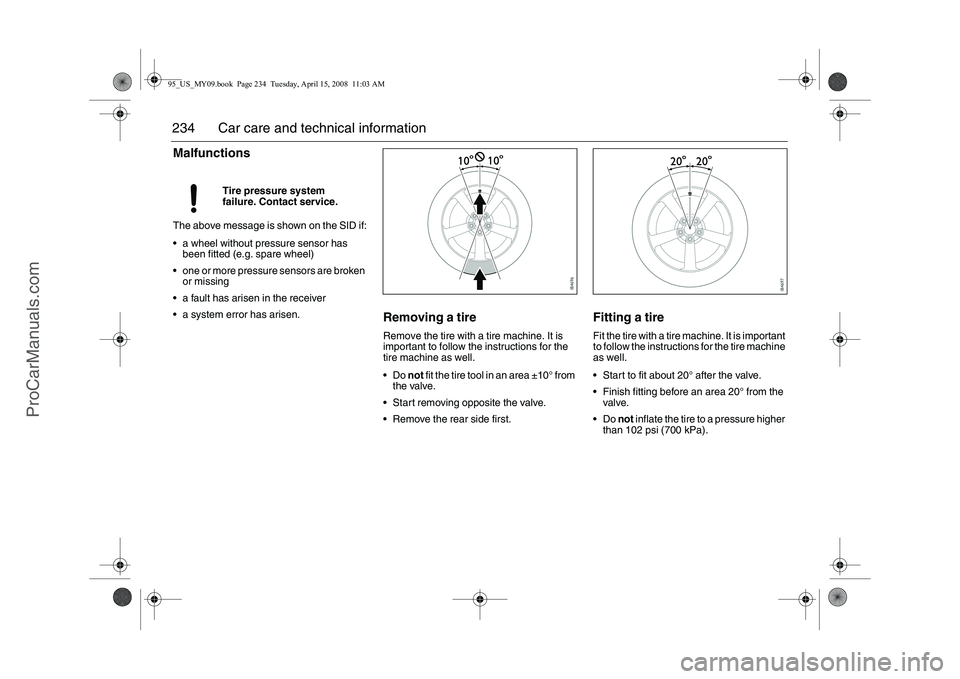
234 Car care and technical informationMalfunctionsThe above message is shown on the SID if:
a wheel without pressure sensor has
been fitted (e.g. spare wheel)
one or more pressure sensors are broken
or missing
a fault has arisen in the receiver
a system error has arisen.
Removing a tireRemove the tire with a tire machine. It is
important to follow the instructions for the
tire machine as well.
Do not fit the tire tool in an area ±10° from
the valve.
Start removing opposite the valve.
Remove the rear side first.
Fitting a tireFit the tire with a tire machine. It is important
to follow the instructions for the tire machine
as well.
Start to fit about 20° after the valve.
Finish fitting before an area 20° from the
valve.
Do not inflate the tire to a pressure higher
than 102 psi (700 kPa). Tire pressure system
failure. Contact service.
95_US_MY09.book Page 234 Tuesday, April 15, 2008 11:03 AM
ProCarManuals.com
Page 236 of 272
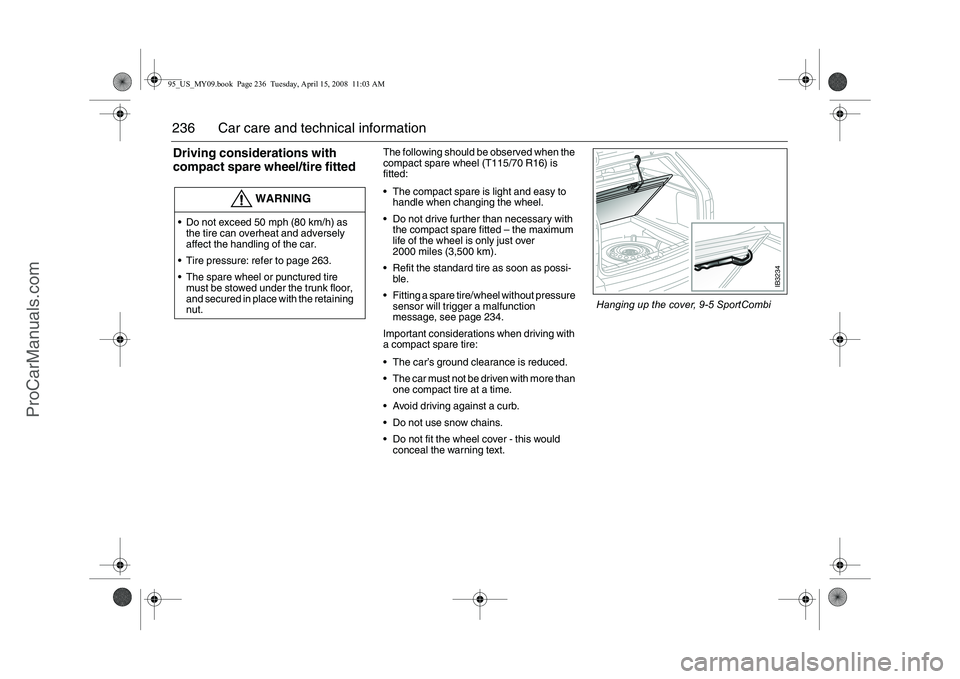
236 Car care and technical informationDriving considerations with
compact spare wheel/tire fitted
The following should be observed when the
compact spare wheel (T115/70 R16) is
fitted:
The compact spare is light and easy to
handle when changing the wheel.
Do not drive further than necessary with
the compact spare fitted – the maximum
life of the wheel is only just over
2000 miles (3,500 km).
Refit the standard tire as soon as possi-
ble.
Fitting a spare tire/wheel without pressure
sensor will trigger a malfunction
message, see page 234.
Important considerations when driving with
a compact spare tire:
The car’s ground clearance is reduced.
The car must not be driven with more than
one compact tire at a time.
Avoid driving against a curb.
Do not use snow chains.
Do not fit the wheel cover - this would
conceal the warning text.
WARNING
Do not exceed 50 mph (80 km/h) as
the tire can overheat and adversely
affect the handling of the car.
Tire pressure: refer to page 263.
The spare wheel or punctured tire
must be stowed under the trunk floor,
and secured in place with the retaining
nut.
IB3234
Hanging up the cover, 9-5 SportCombi
95_US_MY09.book Page 236 Tuesday, April 15, 2008 11:03 AM
ProCarManuals.com
Page 242 of 272
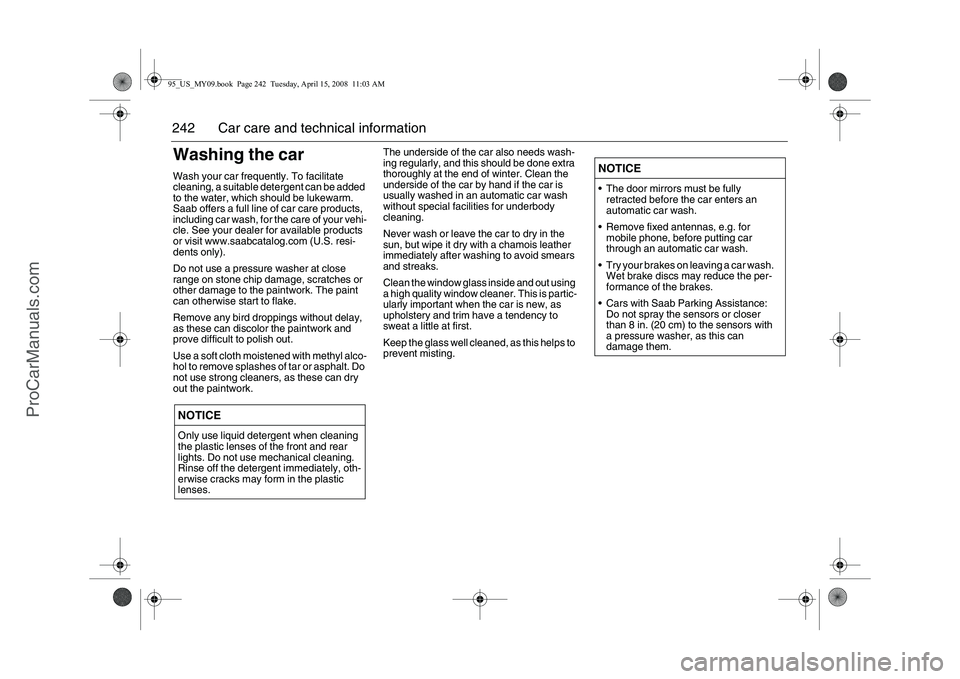
242 Car care and technical informationWashing the carWash your car frequently. To facilitate
cleaning, a suitable detergent can be added
to the water, which should be lukewarm.
Saab offers a full line of car care products,
including car wash, for the care of your vehi-
cle. See your dealer for available products
or visit www.saabcatalog.com (U.S. resi-
dents only).
Do not use a pressure washer at close
range on stone chip damage, scratches or
other damage to the paintwork. The paint
can otherwise start to flake.
Remove any bird droppings without delay,
as these can discolor the paintwork and
prove difficult to polish out.
Use a soft cloth moistened with methyl alco-
hol to remove splashes of tar or asphalt. Do
not use strong cleaners, as these can dry
out the paintwork.
The underside of the car also needs wash-
ing regularly, and this should be done extra
thoroughly at the end of winter. Clean the
underside of the car by hand if the car is
usually washed in an automatic car wash
without special facilities for underbody
cleaning.
Never wash or leave the car to dry in the
sun, but wipe it dry with a chamois leather
immediately after washing to avoid smears
and streaks.
Clean the window glass inside and out using
a high quality window cleaner. This is partic-
ularly important when the car is new, as
upholstery and trim have a tendency to
sweat a little at first.
Keep the glass well cleaned, as this helps to
prevent misting.
NOTICEOnly use liquid detergent when cleaning
the plastic lenses of the front and rear
lights. Do not use mechanical cleaning.
Rinse off the detergent immediately, oth-
erwise cracks may form in the plastic
lenses.
NOTICE The door mirrors must be fully
retracted before the car enters an
automatic car wash.
Remove fixed antennas, e.g. for
mobile phone, before putting car
through an automatic car wash.
Try your brakes on leaving a car wash.
Wet brake discs may reduce the per-
formance of the brakes.
Cars with Saab Parking Assistance:
Do not spray the sensors or closer
than 8 in. (20 cm) to the sensors with
a pressure washer, as this can
damage them.
95_US_MY09.book Page 242 Tuesday, April 15, 2008 11:03 AM
ProCarManuals.com
Page 269 of 272

269 Index
Immobilizer
_____________________ 49
Indicator and warning lights
________ 58
Indicator lights
___________________ 58
Information about fuel
____________ 148
Instrument illumination ____________ 75
Instruments and controls ___________ 57
Interior equipment
_______________ 113
Interior lighting
_________________ 124
Interior rearview mirror
___________ 116
JJack
__________________________ 238
KKey
___________________________ 44
Key, remove
___________________ 140
LLATCH (child safety)
______________ 23
Labeling, tire sidewall ____________ 227
Labels
__________________________ 7
Leather upholstery, care of
________ 241
Light horn
______________________ 73
Light switches ___________________ 73
Loading MP3 discs
______________ 102
Loading your vehicle _____________ 229
Luggage-compartment lighting
_____ 125
MMP3 player
____________________ 102
Main instrument panel
_____________ 58
Main/dipped beam
________________ 73
Maintenance schedule
___________ 252
Maintenance, A/C-system _________ 244
Maxi fuses
_____________________ 215
Milometer ______________________ 64
Moonroof ______________________ 123
Motoring abroad
________________ 247
Multipath propagation
____________ 109
NNIGHT
_________________________ 72
New tires, buying
________________ 223
Night Panel
_____________________ 72
OOdometer
______________________ 64
Oil capacity, engine
______________ 260
Oil specification
_________________ 260
Outdoor temperature
______________ 68
Owner assistance
_______________ 253
PPaintwork, touching-in
____________ 243
Parcel shelf, folding
______________ 133Parking Assistance
______________ 168
Parking lights
____________________ 73
Plates and labels
________________ 264
Poly-V-belt
_____________________ 199
Portable fuel container
___________ 148
Portable player
_________________ 104
Power outlet
___________________ 126
Power steering _________________ 196
Power-steering fluid
______________ 196
Pressure gauge
__________________ 67
Prestige
_______________________ 107
Programme type ALARM
__________ 99
QQuality grading, tires
_____________ 224
Questions on function of airbag
______ 40
RRDS time
______________________ 106
Radiator fan ____________________ 199
Radio
__________________________ 93
Radio Data System (RDS)
_________ 94
Radio text
______________________ 94
Radio waves ___________________ 110
Rain sensor _____________________ 77
Random playback of MP3 files, CD
__ 103
Random playback, CD
____________ 99
Random playback, CD changer
____ 101
Rapid playing an MP3 file
_________ 103
95_US_MY09.book Page 269 Tuesday, April 15, 2008 11:03 AM
ProCarManuals.com